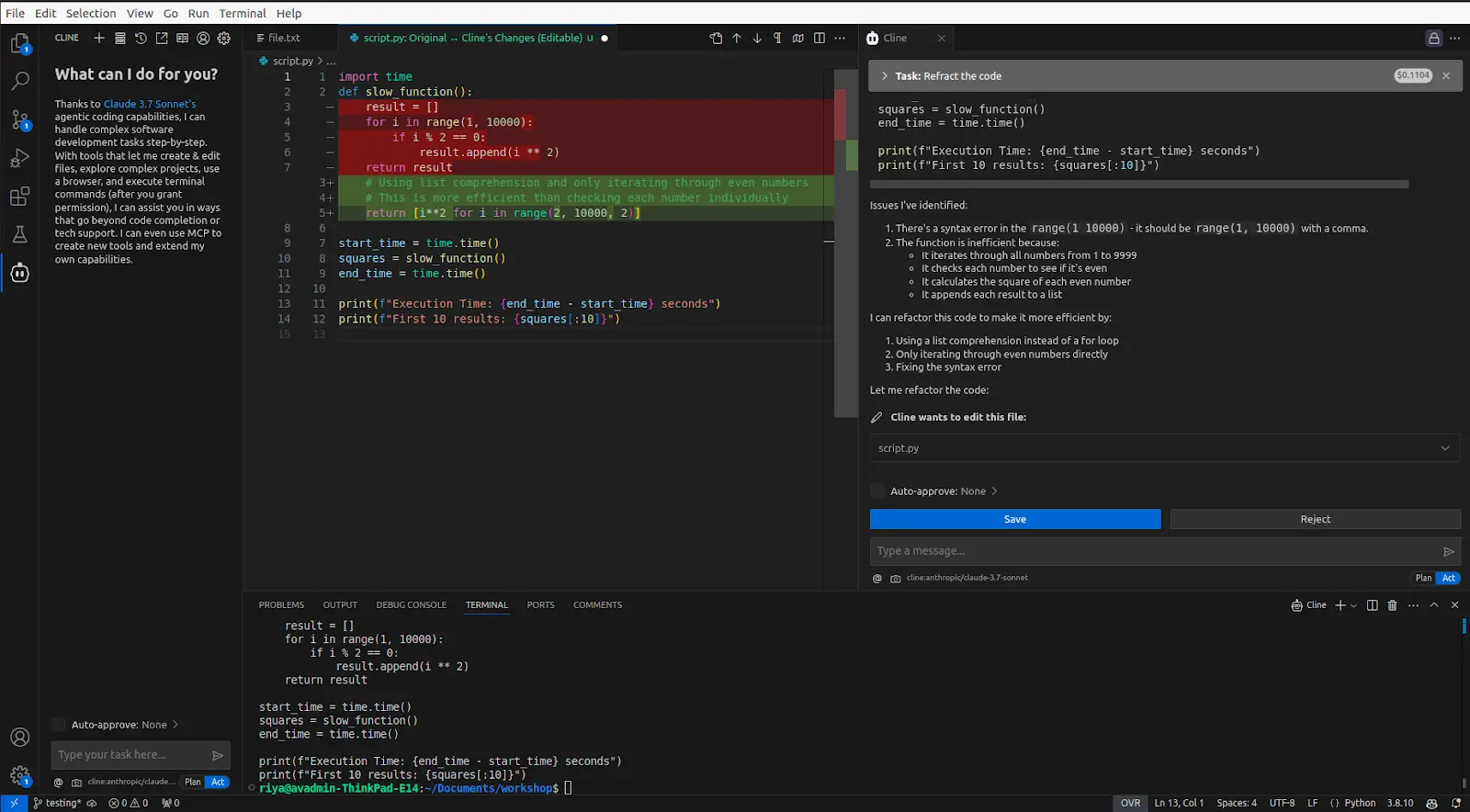Still writing every line of code yourself? Jumping between tabs, searching for answers, and hoping things just work? There’s a new way to code now. AI editors can understand what you’re building from a simple prompt. They help you write, fix, and improve code without getting in the way. In this guide, we’ll look at some of the best AI code editors that make coding feel smoother, faster, and way less messy.

Table of contents
1. Cursor AI
Cursor emerges as a cutting-edge AI-enhanced code editor designed to revolutionize software development through intelligent assistance. By leveraging state-of-the-art transformer models, Cursor goes beyond traditional autocomplete, providing deep contextual understanding of coding patterns. The platform’s core strength lies in its ability to learn from individual developer behaviors, creating a personalized coding experience that adapts in real-time. Its advanced machine learning algorithms analyze code structure, programming idioms, and project-specific contexts to generate highly accurate and contextually relevant suggestions.
Key Technological Capabilities
- Deep learning-based code completion
- Real-time error prediction and prevention
- Cross-platform cloud synchronization
- Adaptive machine learning algorithms
Pricing
Cursor offers a free tier with 500 monthly AI code suggestion credits, providing basic AI-assisted features for developers to explore. The premium plan is priced at $15 per month, expanding capabilities with 5,000 AI code suggestion credits. This tier includes advanced AI features, full cloud-based storage, and enhanced code suggestions for more sophisticated coding needs.

System Requirements
- Compatible Operating Systems: Windows 10/11, macOS 11+, Linux (Ubuntu 20.04+)
- Minimum Hardware: 8GB RAM, Intel Core i5 processor
- Recommended: 16GB RAM, SSD storage
Installation Process
- Visit the official Cursor website (cursor.so)
- Download the appropriate version for your operating system
- Run the installation package
- Create an account using email or preferred SSO method
- Activate your chosen subscription tier
Initial Configuration Steps
- Connect primary development repositories
- Configure language-specific preferences
- Enable cloud synchronization
- Customize AI learning parameters for personalized code suggestions
Advantages
- High accuracy in code completion
- Strong debugging and error-handling features
- Real-time adaptive learning
- Cross-platform cloud synchronization
- Personalized AI suggestions
Disadvantages
- Limited support for niche programming languages
- Higher cost compared to traditional editors
- Potential complexity for beginner developers
- Learning curve for advanced features
Hands-on for AI-Powered Article Writing using Cursor
Follow these steps to set up an AI-powered article-writing agent using LangChain in Cursor:
Create a Project Folder: Open your terminal and create a new folder for the project.
mkdir ai_editor
cd ai_editorSet Up a Python Environment: Initialize a virtual environment to manage dependencies.
python -m venv venvActivate the Virtual Environment:
On macOS/Linux:
source venv/bin/activateOn Windows:
venv\Scripts\activateCreate a requirements.txt File: Inside the ai_editor folder, create a requirements.txt file.
touch requirements.txtList Required Dependencies: To build an AI agent that generates articles, include the necessary dependencies.
Langchain
langchain-experimentalSave the Dependencies: Copy the above dependencies into requirements.txt and install them.
pip install -r requirements.txtBuilding the AI Writing Agent
Now, create an app.py file that contains an AI agent. This agent will take an article topic as input and generate a full-length article using LangChain and OpenAI’s API:
Run the script
python app.pyEnter a topic when prompted, and the AI will generate a complete article.
Pro Tip: Cursor’s AI can automatically generate comprehensive unit tests based on your code’s context, potentially reducing test development time by up to 40%. Developers can enable this feature by configuring project-specific testing parameters in the AI settings.
Also Read: I Tried Vibe Coding with Cursor AI and It’s Amazing!
2. Windsurf
Windsurf represents a paradigm shift in AI-powered development environments, utilizing sophisticated reinforcement learning models that transcend conventional code suggestion mechanisms. Unlike static code assistants, Windsurf’s AI dynamically understands and predicts complex organizational coding patterns, effectively creating an intelligent ecosystem that evolves with each interaction. The platform’s unique approach involves creating adaptive learning models that not only suggest code but comprehend broader architectural and design principles, making it particularly powerful for enterprise-level development teams.
Enterprise-Focused Features
- Organizational coding pattern recognition
- Voice-assisted collaboration
- Multi-language snippet suggestions
- Integrated API documentation generation
Pricing
Windsurf provides a free plan with 250 monthly AI suggestion credits, allowing developers to test its intelligent coding ecosystem. The premium tier costs $20 per month and offers 3,000 AI suggestion credits, unlocking advanced features like extended API support and team collaboration tools. This pricing structure caters to development teams seeking comprehensive AI-powered coding assistance.


System Requirements
- Compatible Operating Systems: Windows 11, macOS 12+, Enterprise Linux
- Minimum Hardware: 16GB RAM, Intel Core i7 processor
- Recommended: 32GB RAM, dedicated graphics
Installation Process
- Contact Windsurf enterprise sales team
- Receive customized deployment package
- Install using provided enterprise scripts
- Configure organizational user access
- Set up team collaboration features
Initial Configuration Steps
- Integrate with existing development infrastructure
- Configure voice-assisted collaboration
- Define multi-language support parameters
- Establish organizational coding pattern recognition
Advantages
- Personalized AI suggestions based on coding style
- Advanced AI-driven debugging
- Strong collaboration tools with voice assistance
- Smart snippet recommendation system
- Adaptive reinforcement learning models
Disadvantages
- Steeper learning curve for beginners
- Can be resource-intensive on lower-end machines
- Higher pricing for small teams or individual developers
Hands-On Task with Windsurf: Building a Real-Time Data Dashboard
Task Overview: Create a real-time data visualization dashboard that leverages Windsurf’s enterprise-focused AI capabilities.
Objective: Build an interactive dashboard that displays enterprise metrics with real-time updates.
Initial Prompt: “Create a React-based real-time dashboard for monitoring enterprise KPIs.”

Observations:
- Windsurf suggested appropriate enterprise libraries and components
- Initial implementation lacked proper error handling for data streams
- Basic authentication was implemented but needed security enhancements
Follow-up Prompt: “Add enterprise-grade authentication and improved error recovery for data streams.”

Final Implementation Results:
- Successfully implemented real-time data visualization with multiple chart types.
- Added secure authentication with role-based access control.
- Implemented proper error handling for intermittent network connections.
- Dashboard included customizable views based on user preferences.
Key Features Implemented:
- Real-time data streaming using enterprise WebSocket protocols.
- Interactive filtering and sorting of KPI data.
- Responsive design for desktop and mobile access.
- Secure data transmission with proper encryption.
Pro Tip: Windsurf introduces a revolutionary “Voice Coding” feature that allows developers to generate and modify code using natural language commands, making it the first AI editor to offer near-conversational programming capabilities.
Also Read: Guide on Vibe Coding with Windsurf
3. VS Code with Copilot
GitHub Copilot’s integration with Visual Studio Code represents a groundbreaking fusion of massive public code repositories and advanced AI modeling. Powered by OpenAI’s Codex model, which has been trained on billions of lines of publicly available code, Copilot transforms the traditional coding experience into an intelligent, collaborative process. The technology goes beyond simple code completion, offering contextual understanding that can generate entire functions, explain complex programming concepts, and provide alternative implementation strategies.
Key Technological Capabilities
- AI-powered code suggestions leveraging GitHub’s massive code repository
- Contextual code generation and completion
- Multi-language support with intelligent context understanding
- Automated boilerplate code generation
- Deep integration with GitHub and version control systems
- Extensive extension marketplace
Pricing
GitHub Copilot’s individual plan is priced at $10 monthly, providing 2,000 AI code generation credits with full access to its intelligent code suggestion system. The business plan at $19 per month increases the credits to 5,000, adding team collaboration features, enhanced security, and priority support. This approach supports both individual developers and professional teams.

System Requirements
- Compatible Operating Systems: Windows 10/11, macOS 10.15+, Linux
- Minimum Hardware: 8GB RAM, modern multi-core processor
- Recommended: 16GB RAM, SSD storage
Installation Process
- Download Visual Studio Code from official website
- Complete standard VS Code installation
- Open Extensions Marketplace
- Search and install “GitHub Copilot”
- Authorize GitHub account access
- Subscribe to GitHub Copilot service
Initial Configuration Steps
- Link primary GitHub repositories
- Customize AI suggestion sensitivity
- Configure language-specific AI assistance
- Set up version control integration
Advantages
- Highly customizable with thousands of extensions
- Strong community support
- Affordable AI assistance compared to other tools
- Extensive integration with GitHub
- Comprehensive multi-language support
Disadvantages
- Requires GitHub Copilot subscription for AI features
- Can be overwhelming due to extensive configurations
- Potential information overload
- Dependency on internet connectivity for full features
Hands-On Guide: Using GitHub Copilot in VS Code
Task 1: Auto-Generate a Python Function
- Open VS Code and create a new Python file (example.py).
- Type the following comment:
# Function to check if a number is prime - Press Enter and wait for the Copilot’s suggestion.
- If the suggestion is correct, press Tab to accept it.

- Run the script by opening a terminal and executing: python example.py
Task 2: Generate a JavaScript Function
- Create a new JavaScript file (script.js).
- Type the following comment:
// Function to reverse a string - Press Enter and wait for the Copilot’s suggestion.
- Accept the suggestion using Tab and test it in the console.

Pro Tip: GitHub Copilot can now generate entire documentation alongside code, creating inline comments and markdown documentation that explain complex algorithmic implementations, significantly reducing manual documentation efforts.
Also Read: Getting Started with GitHub Copilot Workspace
4. Replit
Replit pioneers a cloud-native approach to AI-assisted development, reimagining the coding environment as a fully integrated, intelligent platform. Its AI assistant, Ghostwriter, is designed to lower barriers to entry in software development by providing real-time, context-aware coding guidance. By operating entirely in the cloud, Replit enables seamless multi-device access and collaborative coding experiences. The platform’s AI is specifically engineered to support learners and rapid prototypers, offering intelligent suggestions that adapt to various skill levels and programming contexts.
Key Technological Capabilities
- Cloud-based AI coding assistant (Ghostwriter)
- Real-time collaborative coding environment
- Instant code execution without local setup
- Multi-language development support
- AI-powered code suggestion and debugging assistance
- Cross-device synchronization
Pricing
Replit’s free tier offers 100 monthly AI coding assistance credits, enabling beginners to explore its cloud-native development environment. The premium plan at $7 per month increases credits to 1,500, unlocking enhanced AI-powered features and improved performance. This pricing model aims to make AI-assisted coding more accessible to learners and rapid prototypers.

System Requirements
- Compatible Browser: Chrome 90+, Firefox 88+, Safari 14+
- Stable internet connection
- No specific local hardware requirements
Installation Process
- Navigate to replit.com
- Create user account
- Select preferred programming languages
- Enable Ghostwriter AI assistant
- Configure learning and collaboration preferences
Initial Configuration Steps
- Utilize multi-device synchronization
- Enable instant code sharing
- Activate learning mode for skill development
- Explore collaborative coding features
Advantages
- Accessible from any device with an internet connection
- Ideal for quick prototyping and testing
- Strong AI-assisted learning features
- Instant code execution without setup
- Integrated learning and tutorial support
Disadvantages
- Requires an internet connection for full functionality
- Limited offline capabilities
- Less suitable for complex, large-scale projects
- Potential performance limitations
Hands-On Task: AI-Powered Habit Tracker App
In this hands-on task, we will use Replit’s AI capabilities to build a Habit Tracker App. The app will allow users to log, track, and visualize their habits using an AI-generated code structure.
Enter your prompt: “Make a habit tracker app where I can visualize my habits and routines.”
Check the features that you want your App to have and the agent will start working.

As you can see, coding files are being created and you can also modify features by adding new prompts.

Final preview of our App.

Pro Tip: Replit’s Ghostwriter AI offers a unique “Learning Mode” that breaks down complex code suggestions into step-by-step explanations, making it an invaluable tool for coding education and skill development.
Also Read: A Comprehensive Guide on Replit Agent
5. Cline
Cline represents the pinnacle of enterprise-grade AI development tools, specifically engineered to address the complex needs of large-scale software development. Its technological foundation is built on advanced machine learning models that not only provide code suggestions but conduct comprehensive performance and security analyses. Unlike conventional IDE tools, Cline’s AI integrates deeply with CI/CD pipelines, offering predictive insights into potential performance bottlenecks, security vulnerabilities, and optimization opportunities. The platform’s intelligent system continuously learns from organizational coding patterns, creating an adaptive development environment that enhances both productivity and code quality.
Key Technological Capabilities
- AI-driven performance analytics
- Comprehensive security vulnerability scanning
- Automated code review and optimization
- Deep integration with CI/CD pipelines
- Enterprise-level development support
- Real-time security and performance monitoring
Pricing
Cline provides a free trial with 200 AI analysis credits to demonstrate its enterprise-grade capabilities. Enterprise plans start at $25 per month, offering 10,000 AI analysis credits with comprehensive security features and performance analytics. This pricing structure targets large-scale software development environments seeking advanced AI-driven development tools.

System Requirements
- Compatible Operating Systems: Windows Server 2019+, macOS 11+, Enterprise Linux
- Minimum Hardware: 32GB RAM, enterprise-grade processor
- Recommended: 64GB RAM, dedicated security-optimized infrastructure
Installation Process
- Contact Cline enterprise sales representative
- Receive customized installation package
- Deploy using enterprise-specific scripts
- Integrate with existing CI/CD pipelines
- Configure comprehensive security monitoring
Initial Configuration Steps
- Deep integration with development infrastructure
- Implement comprehensive security scanning
- Set up performance analytics dashboards
- Define and enforce organizational coding standards
Advantages
- Excellent for enterprise software development
- Strong security and performance analysis
- Seamless CI/CD integration
- AI-driven documentation generation
- Comprehensive performance analytics
Disadvantages
- Higher cost compared to other AI editors
- Not as beginner-friendly
- Requires significant organizational infrastructure
- Potentially complex setup for smaller teams
Hands-on Task: Using Cline AI to Refactor and Improve Code Efficiency
Use Cline AI to refactor and optimize a Python script by improving its efficiency and readability.
Step 1: Install CLine Extension in VS Code
- Open VS Code.
- Go to Extensions (Ctrl + Shift + X or Cmd + Shift + X on macOS).
- Search for Cline and install the extension.
- Restart VS Code if required.
Step 2: Set Up a Python Script for Optimization
Open VS Code and create a new project folder:
mkdir cline_ai
cd cline_aiCreate a Python script (script.py) with the following inefficient code:
import time
def slow_function():
result = []
for i in range(1, 10000):
if i % 2 == 0:
result.append(i ** 2)
return result
start_time = time.time()
squares = slow_function()
end_time = time.time()
print(f"Execution Time: {end_time - start_time} seconds")
print(f"First 10 results: {squares[:10]}")Step 3: Use Cline AI to Optimize the Code
- Highlight the slow_function code block in script.py.
- Right-click and select “Refactor with Cline” or use the command palette (Ctrl + Shift + P) and type:
CLine: Refactor Selected Code - Let Cline analyze and suggest an optimized version.
- Accept the optimized suggestion and test the performance improvement.

Step 4: Test the Optimized Code
Run the script before and after applying Cline’s suggestions:
python script.pyCompare the execution time and results.
Step 5: Use Cline AI for Documentation and Explanation
- Highlight the optimized function and use Cline AI to generate a docstring explaining its purpose and improvements.
- Use Cline AI to add comments to make the code more readable.

Expected Outcome
- The refactored code should be faster and more efficient.
- You should have clear documentation generated using Cline AI.
You’ll gain experience using Cline’s AI-powered code improvements.
Pro Tip: Cline introduces an innovative “Predictive Performance Scoring” system that provides developers with a real-time performance rating for their code, helping identify potential optimization opportunities before deployment.
How we Selected these Code Editors?
Our rigorous evaluation framework considered six critical dimensions:
- AI Intelligence: Accuracy of code suggestions and predictive capabilities
- Language Support: Breadth of programming language compatibility
- Collaboration Features: Real-time sharing and team integration
- Performance: Resource utilization and system requirements
- Pricing Accessibility: Cost-effectiveness for different user segments
- Learning Adaptability: How quickly the AI adapts to individual coding style
Comprehensive Comparative Analysis
Below we will look into the comparative analysis of different AI-powered code editors:
| Editor | Best For | AI Accuracy | Price Range | Key Differentiator | Practical Implementation Pro Tip |
| Cursor | AI/ML Development | High | $15-$30/month | Personalized Learning | Use machine learning project templates to maximize AI suggestion accuracy |
| Windsurf | Enterprise Teams | Very High | $20-$40/month | Adaptive Suggestions | Create team-wide coding style guides to improve AI pattern recognition |
| VS Code with Copilot | Versatile Development | High | $10-$20/month | Extensive Ecosystem | Leverage GitHub repositories to train Copilot on your specific coding patterns |
| Replit | Beginners & Prototyping | Medium | Free-$10/month | Cloud-Based Accessibility | Use collaborative coding features for pair programming and real-time learning |
| Cline | Large-Scale Applications | High | $25-$50/month | Security & Performance | Integrate CI/CD pipelines to maximize automated code optimization |
Conclusion
AI code editors are no longer just tools—they’re becoming quiet collaborators in the development process. Whether it’s Cursor’s personalized suggestions, Copilot’s context-aware completions, or Replit’s beginner-friendly setup, these editors are helping developers stay in flow and build with less friction. So, which one’s your favorite? Let me know in the commentscurious to hear how you’re using these tools in your workflow.





